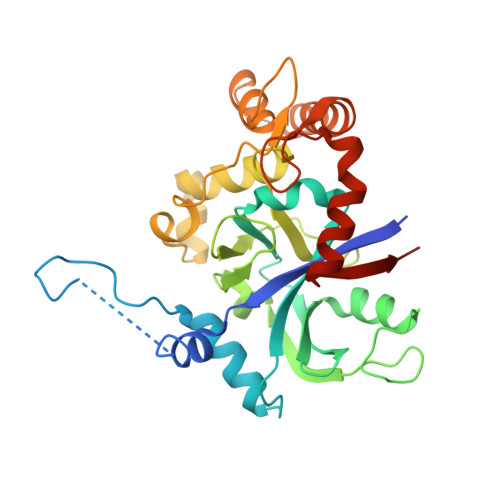Peripheral insertion modulates the editing activity of the isolated CP1 domain of leucyl-tRNA synthetase
Liu, R.J., Tan, M., Du, D.H., Xu, B.S., Eriani, G., Wang, E.D.(2011) Biochem J 440: 217-227
- PubMed: 21819379
- DOI: https://doi.org/10.1042/BJ20111177
- Primary Citation of Related Structures:
3PZ0, 3PZ5, 3PZ6 - PubMed Abstract:
A large insertion domain called CP1 (connective peptide 1) present in class Ia aminoacyl-tRNA synthetases is responsible for post-transfer editing. LeuRS (leucyl-tRNA synthetase) from Aquifex aeolicus and Giardia lamblia possess unique 20 and 59 amino acid insertions respectively within the CP1 that are crucial for editing activity. Crystal structures of AaLeuRS-CP1 [2.4 Å (1 Å=0.1 nm)], GlLeuRS-CP1 (2.6 Å) and the insertion deletion mutant AaLeuRS-CP1Δ20 (2.5 Å) were solved to understand the role of these insertions in editing. Both insertions are folded as peripheral motifs located on the opposite side of the proteins from the active-site entrance in the CP1 domain. Docking modelling and site-directed mutagenesis showed that the insertions do not interact with the substrates. Results of molecular dynamics simulations show that the intact CP1 is more dynamic than its mutant devoid of the insertion motif. Taken together, the data show that a peripheral insertion without a substrate-binding site or major structural role in the active site may modulate catalytic function of a protein, probably from protein dynamics regulation in two respective LeuRS CP1s. Further results from proline and glycine mutational analyses intended to reduce or increase protein flexibility are consistent with this hypothesis.
Organizational Affiliation:
State Key Laboratory of Molecular Biology, Institute of Biochemistry and Cell Biology, Shanghai Institutes for Biological Sciences, The Chinese Academy of Sciences, Shanghai 200031, People's Republic of China.














